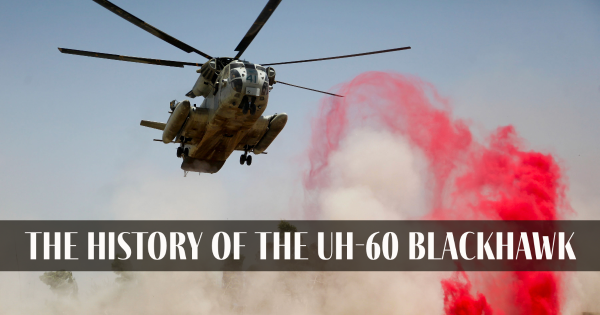UH 60 Helicopter Upkeep: A Comprehensive Guide for Pilots
UH 60 Helicopter Upkeep: A Comprehensive Guide for Pilots
Blog Article
Recognizing the Mechanics and Engineering Behind Uh 60 Helicopters
The UH-60 helicopter, frequently recognized as the Black Hawk, stands as a peak of modern-day rotorcraft technology, embodying a blend of robust engineering and intricate mechanics. As we peel back the layers of the UH-60's design, a world of intricate systems and meticulous engineering comes to light.
History of UH-60 Helicopters
The history of UH-60 helicopters traces back to the late 1970s when the United States Military looked for a functional and innovative utility helicopter to change its aging fleet. In action to this requirement, the Sikorsky Aircraft Firm established the UH-60 Black Hawk helicopter. Introduced in 1979, the UH-60 quickly came to be a staple in army operations due to its remarkable capacities.
The UH-60 was developed to excel in a selection of objectives, including army transportation, medical discharge, electronic warfare, and unique operations. Its capacity to adapt to various functions made it an important property to the united state Army and various other military pressures around the world
For many years, the UH-60 system has gone through numerous upgrades and variants to improve its performance and maintain speed with developing goal demands. These helicopters have actually seen substantial service in disputes such as the Gulf Battle, Afghanistan, and Iraq, showcasing their dependability and versatility in diverse functional atmospheres. The UH-60's rich background is a testament to its enduring heritage as a premier energy helicopter.

Engine and Power Equipments
Making use of sophisticated propulsion modern technology, UH-60 helicopters are furnished with sophisticated engine and power systems to guarantee optimal performance and integrity in an array of functional situations. The UH-60, typically recognized as the Black Hawk, is powered by 2 General Electric T700-GE-701D engines, each with the ability of providing up to 1,940 shaft horse power. These turboshaft engines provide the needed thrust for the helicopter to execute its objectives successfully, including army transportation, medical discharge, and fight support.

Rotor System and Aerodynamics
How do the rotor system and the rules of aerodynamics of UH-60 helicopters add to their functional effectiveness and trip abilities? The rotor system of the UH-60 helicopter plays an important function in offering lift and propulsion. The UH-60 features a four-bladed, fully articulated blades system that permits high ability to move and security during trip. This layout makes it possible for the helicopter to do a large variety of objectives, from transport and clinical discharge to deal with operations.
Aerodynamics also play a vital function in the performance of UH-60 helicopters. The structured fuselage and blades blade layout decrease drag, permitting the helicopter to achieve higher rates and much better fuel performance. The aerodynamic layout of the UH-60 likewise adds to its capacity to operate in diverse environmental problems, including warm temperatures and high elevations.
Avionics and Flight Control Equipment

In its complex control with the blades system and aerodynamics of UH-60 helicopters, the avionics and flight control systems develop a critical network of technologies shaping the airplane's functional capacities. In the UH-60, these systems consist of digital displays, interaction radios, General practitioner navigating, weather radar, and autopilot systems.
The flight Find Out More control systems of the UH-60 are in charge of converting the pilot's inputs right into the ideal adjustments to the rotor system, guaranteeing steady flight and maneuverability. These systems include hydraulic actuators, servos, and computer systems that interact to regulate the major and tail blades, along with various other trip control surface areas. By exactly handling the helicopter's trip characteristics, these systems make it possible for pilots to do a wide range of missions, from transport and search-and-rescue to combat procedures, with accuracy and self-confidence.
Function and Applications in Air Travel
The function and applications of avionics and flight control systems in aviation are essential to guaranteeing the safe and effective procedure of aircraft, consisting of UH-60 helicopters. Avionics systems in UH-60 helicopters incorporate a series of electronic systems that help in navigating, interaction, surveillance, and controlling numerous airplane functions. These systems consist of electronic display screens, autopilot systems, interaction radios, general practitioner navigating equipment, and weather condition radar. Flight control systems play an essential duty in navigating the helicopter in the air, keeping security, and making sure accurate movements. The fly-by-wire modern technology made use of in contemporary UH-60 helicopters translates pilot inputs right into electronic signals, which are after that translated by the flight control computer systems to change the airplane's control surfaces. Additionally, these systems include safety attributes such as autopilot modes, terrain understanding advising systems, and stability enhancement systems to improve the total security and functional abilities of the UH-60 helicopters in various objectives, including troop transportation, medical discharge, search and rescue, and aerial firefighting.
Conclusion
In final thought, the UH-60 helicopter is a functional airplane with an abundant background and progressed engineering. Its engine and power systems, blades system, aerodynamics, avionics, and flight control systems all work together to make it a effective and reputable maker.
In its complex sychronisation with the blades system and aerodynamics of UH-60 helicopters, the avionics and flight control systems form a vital network of innovations forming the aircraft's functional abilities.The flight control systems of the UH-60 are responsible for translating the pilot's inputs right into the ideal changes to the rotor system, guaranteeing stable trip and ability to move. Avionics systems in UH-60 helicopters include a range of electronic systems that help in navigation, communication, surveillance, and managing different aircraft features. Furthermore, these systems incorporate safety and security functions such as autopilot settings, dig this terrain awareness advising see here now systems, and stability augmentation systems to boost the general safety and functional capabilities of the UH-60 helicopters in numerous objectives, including army transport, clinical emptying, search and rescue, and airborne firefighting.
Its engine and power systems, blades system, aerodynamics, avionics, and trip control systems all work with each other to make it a reputable and reliable machine.
Report this page